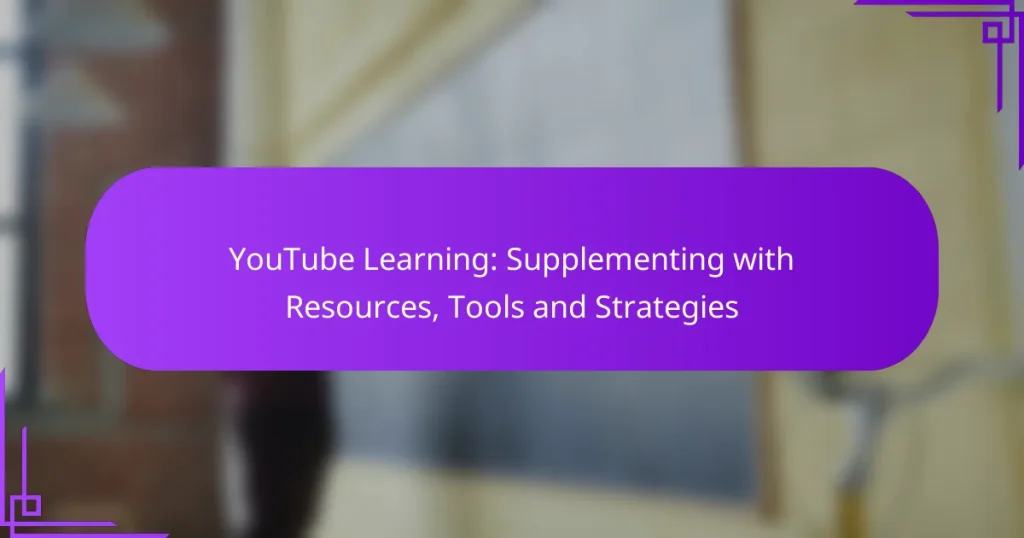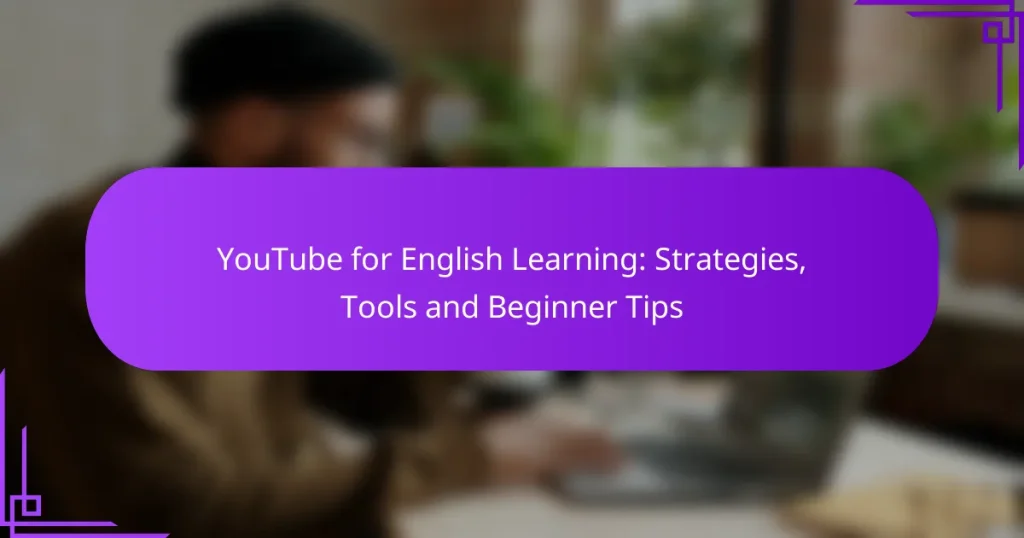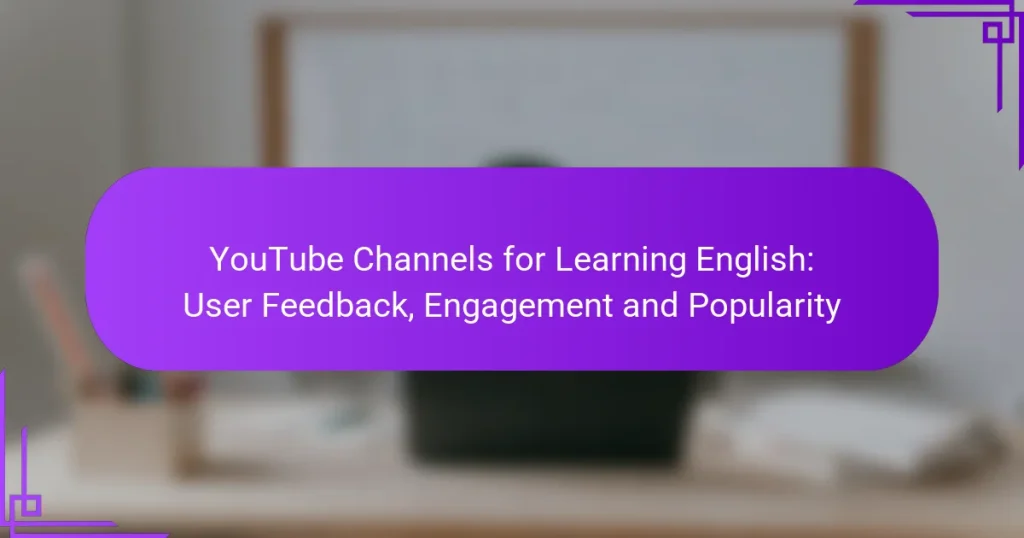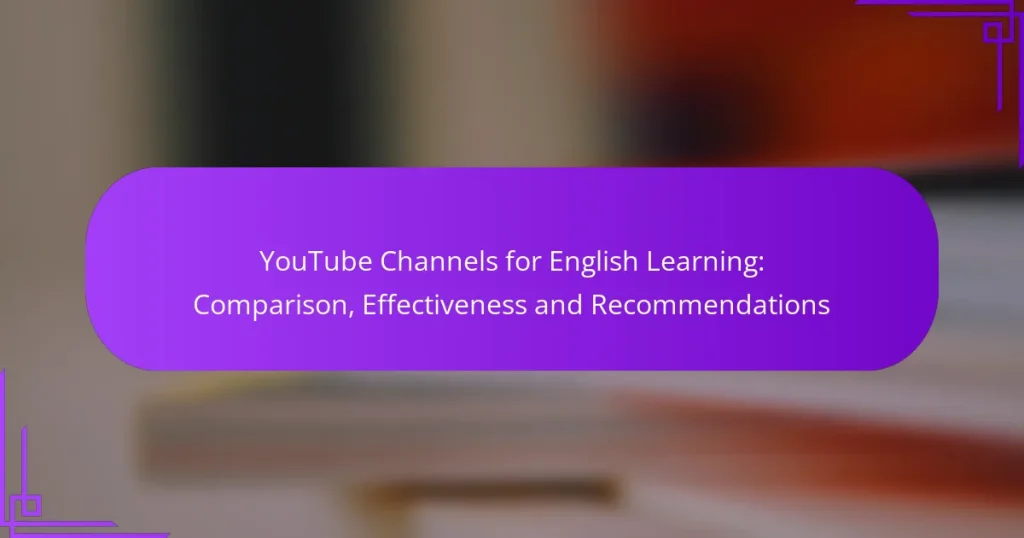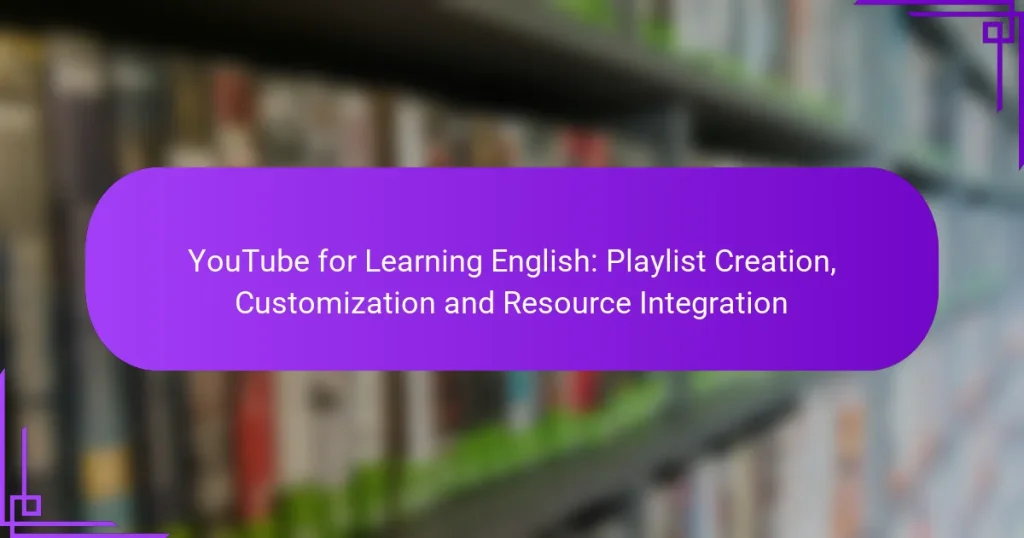YouTube offers a wealth of resources for learning English, featuring channels like BBC Learning English and English with Lucy. These platforms provide engaging lessons and practical tips that cater to various skill levels, making language acquisition both enjoyable and effective. By utilizing diverse content, learners can enhance their listening, speaking, and comprehension skills in a relatable context.
YouTube for English Learning: Strategies, Tools and Beginner Tips
YouTube Channels for Learning English: Engagement, Content Quality and Teaching Style
YouTube Channels for Learning English: User Feedback, Engagement and Popularity
YouTube Channels for English Learning: Comparison, Effectiveness and Recommendations
YouTube for Learning English: Playlist Creation, Customization and Resource Integration
Visual Learning: Impact on English Language Acquisition, Retention and Engagement
What are the best YouTube channels for learning English?
Some of the best YouTube channels for learning English include BBC Learning English, English with Lucy, Rachel’s English, EngVid, and Learn English with Emma. These channels offer a variety of lessons, tips, and resources tailored to different skill levels and learning styles.
BBC Learning English
BBC Learning English provides high-quality content that covers grammar, vocabulary, pronunciation, and listening skills. The channel features a range of series, including news reports and drama, which help learners engage with real-world English.
Each lesson is designed to be concise, typically lasting around 5-10 minutes, making it easy to fit into a busy schedule. The use of authentic materials helps learners understand how English is used in various contexts.
English with Lucy
English with Lucy focuses on pronunciation, vocabulary, and practical language skills. Lucy, the host, offers clear explanations and engaging lessons that are suitable for intermediate and advanced learners.
Her videos often include tips on British English nuances and cultural insights, making them particularly valuable for those interested in the UK. The channel also features interactive quizzes to reinforce learning.
Rachel’s English
Rachel’s English specializes in American English pronunciation and accent reduction. Rachel provides detailed tutorials on how to produce specific sounds and improve overall clarity in speech.
The channel includes practice exercises and real-life examples, which help learners develop their speaking skills effectively. Rachel’s approachable style makes complex concepts easier to grasp.
EngVid
EngVid offers a wide range of English lessons taught by multiple experienced teachers. The channel covers topics from grammar and vocabulary to idiomatic expressions and business English.
With hundreds of videos available, learners can choose lessons that match their interests and proficiency levels. EngVid also provides quizzes and additional resources to support learning.
Learn English with Emma
Learn English with Emma focuses on practical language skills, including everyday conversation and exam preparation. Emma’s lessons are designed to be engaging and informative, catering to learners of all levels.
Her channel includes tips for improving writing and speaking skills, as well as strategies for mastering English tests like IELTS. Emma often shares personal anecdotes, making the lessons relatable and enjoyable.
How can YouTube improve English language skills?
YouTube can significantly enhance English language skills by providing diverse content that caters to various learning styles. Through engaging videos, learners can practice listening, speaking, and comprehension in a real-world context, making the learning experience more relatable and effective.
Listening comprehension
YouTube offers a vast array of videos that can help improve listening comprehension in English. By watching content such as interviews, podcasts, and educational videos, learners can expose themselves to different accents, speech patterns, and vocabulary. This exposure helps in understanding spoken English in various contexts.
To maximize listening skills, consider using subtitles initially, then gradually watching without them. Focus on channels that provide clear audio and engaging content to maintain interest and motivation.
Pronunciation practice
Practicing pronunciation is essential for effective communication, and YouTube provides numerous resources for this. Channels dedicated to English language learning often include pronunciation guides, phonetic breakdowns, and speaking exercises. Mimicking native speakers in these videos can help learners improve their accent and intonation.
To enhance pronunciation, select videos that emphasize phonetics and practice along with the speaker. Recording oneself can also be beneficial for identifying areas that need improvement.
Vocabulary expansion
YouTube is a rich resource for vocabulary expansion, offering content across various subjects and interests. By engaging with different genres, learners can encounter new words and phrases in context, which aids retention and understanding. Educational channels often highlight key vocabulary relevant to specific topics.
To effectively expand vocabulary, create a list of new words encountered in videos and review them regularly. Watching content with a focus on specific themes, such as travel or business, can also help learners acquire relevant terminology in those areas.
What are the features of effective English learning channels?
Effective English learning channels typically include engaging content, structured lessons, and interactive exercises. These features help learners stay motivated and ensure they grasp language concepts effectively.
Engaging content
Engaging content captures learners’ attention and makes the learning process enjoyable. Channels that use storytelling, humor, or real-life scenarios can significantly enhance retention and understanding.
Consider channels that incorporate popular culture, such as movies or music, to relate language lessons to familiar contexts. This approach not only makes learning fun but also helps learners connect with the material on a personal level.
Structured lessons
Structured lessons provide a clear roadmap for learners, allowing them to progress systematically through language concepts. Effective channels often break down topics into manageable segments, ensuring that each lesson builds on the previous one.
Look for channels that offer playlists or series focused on specific skills, such as grammar, vocabulary, or pronunciation. This organization helps learners track their progress and revisit challenging areas as needed.
Interactive exercises
Interactive exercises reinforce learning by allowing students to practice what they’ve learned in a hands-on manner. Channels that include quizzes, games, or speaking challenges can significantly enhance engagement and retention.
Seek out channels that provide opportunities for real-time feedback, such as comment sections or live sessions, where learners can ask questions and receive guidance. This interaction fosters a sense of community and support among learners.
How to choose the right YouTube channel for learning English?
Choosing the right YouTube channel for learning English involves understanding your personal learning goals, evaluating the teaching style of the channel, and checking subscriber feedback. This ensures that the content aligns with your needs and preferences, enhancing your learning experience.
Assess learning goals
Start by identifying what you want to achieve with your English learning. Are you focusing on conversational skills, grammar, vocabulary, or perhaps preparing for a specific exam like IELTS or TOEFL? Knowing your goals will help you select channels that specialize in those areas.
For example, if your aim is to improve everyday conversation, look for channels that emphasize speaking practice and real-life dialogues. If you need to prepare for an exam, seek out channels that offer targeted lessons and practice tests.
Evaluate teaching style
Different channels have varying teaching styles, which can significantly impact your learning. Some may use a formal approach with structured lessons, while others might adopt a more casual, conversational tone. Consider which style resonates with you and keeps you engaged.
Watch a few introductory videos from potential channels to gauge their teaching methods. Look for channels that incorporate visuals, examples, and interactive elements, as these can enhance understanding and retention.
Check subscriber feedback
Subscriber feedback is a valuable resource when selecting a YouTube channel for learning English. Look at comments and reviews to see how other learners have benefited from the content. High engagement and positive feedback often indicate quality material.
Pay attention to comments about the effectiveness of the lessons, the clarity of explanations, and the overall learning experience. Channels with a strong community and active discussions can also provide additional support and motivation as you learn.
What are the common pitfalls in learning English on YouTube?
Common pitfalls in learning English on YouTube include passive consumption of content, insufficient opportunities for active practice, and varying learning speeds that can hinder progress. Recognizing these issues can help learners adopt more effective strategies.
Over-reliance on passive watching
Many learners fall into the trap of passive watching, where they consume videos without actively engaging with the material. This approach limits retention and understanding, as learners may not fully process the information presented.
To combat this, viewers should take notes, pause to reflect on what they’ve learned, and even repeat phrases aloud. Engaging with the content actively can significantly enhance language acquisition.
Lack of practice opportunities
Another common issue is the lack of practice opportunities when learning English through YouTube. While videos can provide valuable input, they often do not encourage speaking or writing practice, which are crucial for language development.
To address this, learners should complement video lessons with interactive exercises or language exchange platforms. Practicing speaking with native speakers or writing in online forums can reinforce what is learned from videos.
Inconsistent learning pace
Inconsistent learning pace is a significant challenge for many YouTube learners. Some videos may move too quickly for beginners, while others may be too slow for advanced learners, leading to frustration or boredom.
To maintain a steady learning pace, it is advisable to create a structured study plan that includes a mix of video content tailored to individual skill levels. Setting specific goals, such as watching a certain number of videos per week, can help learners stay on track.
